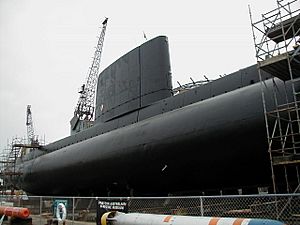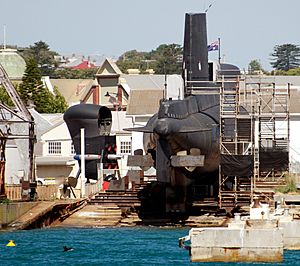HMAS Ovens facts for kids
HMAS Ovens (S 70) was a special type of submarine called an Oberon-class submarine. It used to be part of the Royal Australian Navy (RAN). This submarine was one of six Oberon-class submarines built for Australia by a Scottish company called Scotts Shipbuilding and Engineering Company. It started serving in 1969.
The submarine was named after John Ovens, an Irish explorer who explored parts of Australia. A river in Victoria, Australia, is also named after him. During its time in service, Ovens was the first Australian Navy submarine to work with the ANZUK force. It was also the first Australian Navy submarine to fire a real Mark 48 torpedo, which sank a target ship called Colac. The submarine stopped serving in 1995. Today, you can visit HMAS Ovens at the Western Australian Maritime Museum where it is kept as a museum ship.
Contents
Submarine Design and How It Was Built
The Oberon-class submarines were designed based on an older type of British submarine called the Porpoise class. Engineers made changes to make the Oberon submarines stronger, better at detecting things, and harder to find.
Australia ordered eight of these submarines. The first four, including Ovens, were approved in 1963. Two more were planned later, but their construction was cancelled. The money was then used for the Fleet Air Arm, which is the air force part of the navy. This was the fourth time the Australian Navy tried to create its own submarine group.
Size and Movement
The Ovens submarine was about 90.0 metres (295.2 ft) long. It was 8.1 metres (26.5 ft) wide and sat 5.5 metres (18 ft) deep in the water when on the surface. When it was fully loaded, it weighed about 2,030 tons on the surface and 2,410 tons underwater.
The submarine moved using two propellers. Each propeller was powered by an English Electric motor. These motors got their electricity from two powerful diesel generators. Ovens could travel up to 12 knots (22 km/h; 14 mph) (knots) on the surface and up to 17 knots (31 km/h; 20 mph) underwater. It could travel a very long distance, about 9,000 nautical miles (17,000 km; 10,000 mi) (nautical miles), at 12 knots (22 km/h; 14 mph). The submarine could also dive very deep, up to 200 metres (660 ft) below the sea surface.
Crew and Weapons
When Ovens first started serving, it had a crew of 8 officers and 56 sailors. By the time it stopped serving, the number of sailors had increased to 60. It could also carry up to 16 trainees.
The main weapons on the Oberon submarines were six 21-inch (533.4 mm) torpedo tubes at the front. At first, they carried British Mark 8 torpedoes. Later, these were replaced with wire-guided Mark 23 torpedoes.
Between 1980 and 1982, the Australian Oberon submarines, including Ovens, were updated. They were then able to carry Mark 48 torpedoes from the United States Navy and UGM-84 Sub Harpoon anti-ship missiles. By 1996, a typical load for an Australian Oberon submarine was a mix of 20 Mark 48 Mod 4 torpedoes and Sub Harpoon missiles. Instead of torpedoes, the submarine could also carry Mark 5 Stonefish sea mines, which were launched through the torpedo tubes.
When it first started, Ovens also had two shorter torpedo tubes at the back for Mark 20 anti-submarine torpedoes. However, new wire-guided torpedoes that could be steered made these back-firing torpedoes unnecessary. So, they were sealed off and later removed during a major repair.
Building the Ovens
Ovens was built by the Scotts Shipbuilding and Engineering Company in Greenock, Scotland. Its construction began on 17 June 1966. The submarine was launched into the water on 4 December 1967. It officially joined the Royal Australian Navy on 18 April 1969.
Operational History
HMAS Ovens had an active career, visiting different countries and taking part in important exercises.
In 1970, Ovens sailed to New Zealand and visited several ports there. It returned to New Zealand in late August and early September 1971. During this visit, it helped train ships from the Royal New Zealand Navy in how to find and fight submarines.
In January 1972, Ovens was sent to South East Asia to work with the ANZUK force. This was the first time an Australian Navy submarine had done this. The deployment lasted until June. During this time, the submarine took part in a large exercise called SEATO Exercise Sea Hawk. On 3 August, the submarine found an abandoned boat called Sea Witch floating about 80 kilometres (50 mi) off Newcastle, New South Wales.
In May 1976, the submarine went on a five-and-a-half-month trip to the Far East. Before returning home, Ovens participated in a big international exercise called Kangaroo 2. This exercise pretended that an enemy was attacking a coastal area. Ovens was part of the defending team. During the exercise, Ovens successfully "attacked" many enemy ships, including the large aircraft carrier USS Enterprise. When it returned to its home base, HMAS Platypus, in Sydney Harbour, the crew showed they had achieved a "clean sweep" by tying a broom to the attack periscope. This meant they had successfully completed all their missions.
Ovens made history on 4 March 1987. It became the first Australian Navy submarine to fire a real, armed Mark 48 torpedo. The torpedo sank the old ship HMAS Colac, which was no longer in service. When Ovens returned to port, its crew flew a 'Jolly Roger' flag. This pirate flag is used by submarines to show they had a successful mission. It was the first time an Australian Navy submarine had done this.
In June 1995, the submarine made a port visit to Geelong, Victoria.
Decommissioning and Fate
HMAS Ovens officially stopped serving in the navy on 1 December 1995. In November 1998, the submarine was given to the Western Australian Museum. Today, it is kept as a museum ship at the Western Australian Maritime Museum in Fremantle, Western Australia. Visitors can go inside and learn about life on a submarine.



